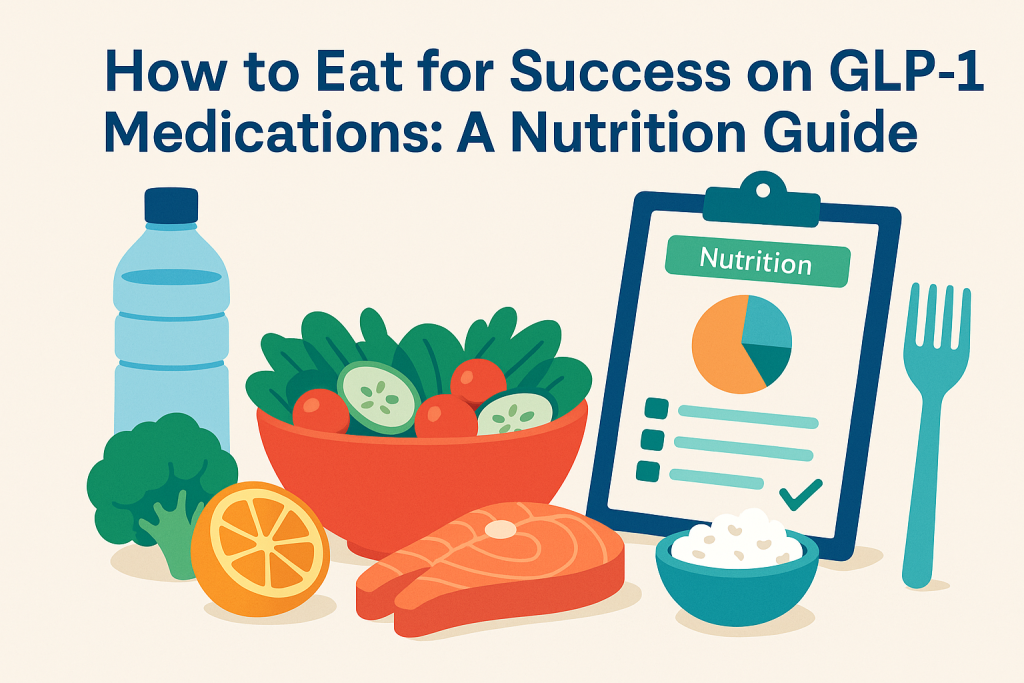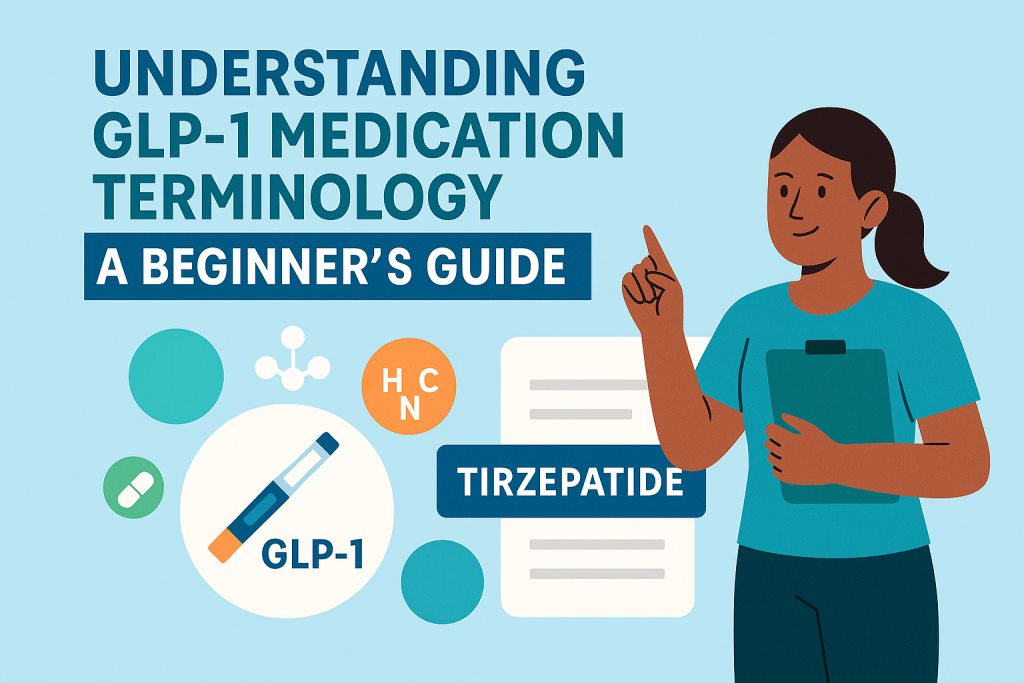- Introduction: Why Diet Still Matters on GLP-1s
- GLP-1-Friendly Macronutrient Breakdown
- Best Foods to Eat
- Foods and Habits That Make Side Effects Worse
- Sample 1-Week GLP-1 Meal Plan
- Grocery Shopping Tips and Label Reading
- How to Track Nutrition in the Pep App
- Eating Out and Social Situations
- Nutrition FAQ
- Start Optimizing Your Nutrition
- Further Reading
Introduction: Why Diet Still Matters on GLP-1s
GLP-1 medications, such as Ozempic, Wegovy, Semaglutide, and Mounjaro, have revolutionized the treatment landscape for obesity and type 2 diabetes, offering impressive results in weight reduction and blood sugar management. While these medications help manage appetite, improve metabolism, and assist significantly in weight loss, dietary habits remain crucial to their overall effectiveness. Relying solely on medication without making necessary dietary adjustments can limit the full potential benefits and, in some cases, may increase side effects. A well-balanced diet that complements GLP-1 medication therapy enhances outcomes, facilitates better tolerance, and supports sustained long-term weight management.
It’s important to recognize that GLP-1 medications are powerful tools but not magic solutions. They work best as part of a holistic approach that includes dietary improvements, physical activity, and behavioral changes. Proper nutrition helps address the underlying causes of metabolic imbalances and obesity by providing the necessary nutrients your body needs to function optimally. Dietary choices influence blood glucose levels, hunger regulation, energy expenditure, and overall health status, making nutrition a critical component of treatment effectiveness.
Moreover, dietary strategies tailored specifically to GLP-1 medication users can significantly reduce common side effects such as nausea, constipation, or bloating, enhancing the medication experience and improving adherence. This guide is intended to offer practical dietary insights to help you optimize your GLP-1 therapy, ensuring both effectiveness and comfort during your weight-loss journey.
GLP-1-Friendly Macronutrient Breakdown
To get the most out of GLP-1 medications, understanding the ideal macronutrient breakdown is essential. The macronutrients—proteins, carbohydrates, and fats—each play distinctive roles in health, weight management, and medication efficacy. An optimal balance supports satiety, stabilizes blood sugar, provides sustained energy, and enhances metabolism.
- Protein (30-40%): High-protein diets are particularly beneficial for individuals on GLP-1 medications. Protein promotes satiety, helping to reduce overall calorie consumption by keeping you fuller longer. It supports muscle mass preservation during weight loss, ensuring that most of the weight loss occurs from fat rather than lean tissue. Additionally, protein stabilizes blood sugar levels by slowing carbohydrate absorption, thereby complementing the glucose-regulating effects of GLP-1 medications.
- Complex Carbohydrates (30-40%): Not all carbohydrates are created equal. Complex carbohydrates such as whole grains, vegetables, legumes, and fruits provide necessary fiber, vitamins, and minerals. The fiber content of these foods slows digestion, helping to maintain steady blood sugar levels and preventing rapid insulin spikes that can trigger hunger and overeating. Complex carbohydrates also support digestive health, reducing the risk of constipation, a common side effect with GLP-1 medications.
- Healthy Fats (25-35%): Despite misconceptions, healthy fats are crucial for maintaining hormonal balance, reducing inflammation, and promoting cardiovascular health. Sources such as avocados, olive oil, nuts, seeds, and fatty fish like salmon provide essential omega-3 fatty acids that help support metabolic health. Healthy fats aid nutrient absorption, improve satiety, and enhance the palatability of meals, making dietary adherence easier.
Balancing these macronutrients effectively creates an environment within the body conducive to sustained weight loss and optimal metabolic function, leveraging the full potential of GLP-1 therapy.
Best Foods to Eat
Incorporating nutrient-dense, GLP-1-friendly foods into your daily diet significantly improves medication outcomes. Prioritizing certain foods based on their nutritional profile can enhance your treatment experience and accelerate progress toward your health goals.
Protein-Rich Foods
- Lean Poultry: Chicken breast and turkey provide high-quality protein with minimal fat, promoting muscle maintenance and satiety.
- Fish and Seafood: Salmon, tuna, and other fatty fish offer protein and heart-healthy omega-3 fatty acids, reducing inflammation and improving cardiovascular health.
- Plant-Based Proteins: Beans, lentils, tofu, tempeh, and legumes are excellent sources of protein and fiber, supporting sustained energy and blood sugar management.
- Dairy Products: Greek yogurt, cottage cheese, and other low-fat dairy options offer protein and calcium, essential for bone health and muscle function.
Fiber-Rich Foods
- Vegetables: Broccoli, Brussels sprouts, kale, spinach, and leafy greens provide vitamins, minerals, and fiber, aiding digestion and promoting satiety.
- Whole Grains: Oats, barley, quinoa, brown rice, and whole-wheat products deliver sustained energy, regulate blood sugar, and support digestive health.
- Fruits: Berries, apples, pears, and citrus fruits offer fiber, vitamins, antioxidants, and natural sweetness without drastic blood sugar spikes.
Hydration
Proper hydration significantly influences medication efficacy and overall health:
- Water Intake: Consuming at least 8-10 glasses of water daily ensures optimal hydration, reducing side effects like headaches, dizziness, and fatigue.
- Herbal Teas: Non-caffeinated herbal teas contribute to hydration while offering calming effects and digestive benefits.
- Infused Waters: Adding natural flavorings like cucumber, lemon, or mint can make drinking water more enjoyable, promoting consistent hydration.
Incorporating these recommended foods regularly into your diet ensures that your body receives adequate nutrients, supports GLP-1 medication effectiveness, and significantly improves your overall treatment experience.
Foods and Habits That Make Side Effects Worse
While GLP-1 medications offer substantial benefits for weight management and blood sugar regulation, certain foods and lifestyle habits can exacerbate potential side effects, reducing treatment effectiveness and comfort. Identifying and minimizing these can significantly improve your experience:
High-Fat and Greasy Foods
Eating high-fat, greasy foods, such as fried items or fatty meats, can slow digestion further, intensifying feelings of nausea, bloating, and gastrointestinal discomfort commonly associated with GLP-1 medications. These foods also negatively impact metabolic health, potentially increasing inflammation and reducing medication efficacy. Opting for healthier preparation methods like grilling, steaming, or baking helps avoid these problems.
High-Sugar and Highly Processed Foods
Consuming sugary or highly processed foods, including candy, pastries, and sugary beverages, can lead to rapid blood sugar spikes and crashes, undermining the metabolic stability GLP-1 medications aim to achieve. These foods often contain additives and preservatives that can irritate the digestive tract, contributing to increased gastrointestinal distress and discomfort. Prioritizing whole, minimally processed foods ensures smoother blood sugar management and reduced side effects.
Alcohol Consumption
Alcohol consumption can exacerbate the gastrointestinal side effects of GLP-1 medications, such as nausea and acid reflux. Additionally, alcohol can interfere with blood sugar management and overall metabolic health. Reducing or eliminating alcohol while on GLP-1 therapy can significantly enhance medication effectiveness and comfort.
Large Meal Sizes
Eating large meals can trigger or worsen gastrointestinal symptoms, such as bloating, nausea, and discomfort, due to the slowed gastric emptying effect of GLP-1 medications. Adopting smaller, more frequent meals throughout the day improves digestion, enhances nutrient absorption, and reduces side-effect severity, supporting better overall medication tolerance.
Lack of Hydration
Insufficient hydration can intensify side effects like headaches, dizziness, and constipation. Proper hydration supports overall digestive health, facilitates nutrient absorption, and assists in managing potential medication-related side effects. Consuming adequate water throughout the day is essential for optimizing medication effectiveness and comfort.
Inconsistent Eating Patterns
Irregular eating habits and skipping meals can exacerbate side effects, increase hunger, and disrupt blood sugar levels. Consistent meal timing and regular dietary patterns enhance metabolic stability and improve the effectiveness of GLP-1 treatments.
Sample 1-Week GLP-1 Meal Plan
Planning your meals in advance can greatly support dietary adherence and optimize your medication’s effectiveness. Here is a structured, balanced one-week meal plan suitable for GLP-1 medication users:
Monday
- Breakfast: Scrambled eggs with spinach and whole-grain toast
- Lunch: Grilled chicken breast salad with mixed greens, avocado, and olive oil dressing
- Dinner: Oven-roasted salmon with quinoa and steamed asparagus
Tuesday
- Breakfast: Greek yogurt with blueberries, chia seeds, and almonds
- Lunch: Black bean soup with a side of mixed greens salad
- Dinner: Turkey stir-fry with bell peppers, broccoli, and brown rice
Wednesday
- Breakfast: Oatmeal topped with sliced banana and peanut butter
- Lunch: Chickpea and veggie wrap with whole-grain tortilla
- Dinner: Grilled shrimp with roasted Brussels sprouts and sweet potatoes
Thursday
- Breakfast: Vegetable omelette with whole-grain toast
- Lunch: Quinoa salad with cucumbers, tomatoes, and feta cheese
- Dinner: Baked tofu with mixed vegetables and soba noodles
Friday
- Breakfast: Cottage cheese with fresh pineapple and walnuts
- Lunch: Lentil salad with mixed veggies and olive oil dressing
- Dinner: Grilled chicken breast with sautéed spinach and brown rice
Saturday
- Breakfast: Smoothie with kale, banana, berries, and protein powder
- Lunch: Tuna salad lettuce wraps with avocado
- Dinner: Veggie-loaded chili with black beans and whole-grain bread
Sunday
- Breakfast: Whole-grain waffles with fresh berries and Greek yogurt
- Lunch: Chicken and vegetable soup with a side salad
- Dinner: Baked cod with wild rice and steamed broccoli
Grocery Shopping Tips and Label Reading
Efficient grocery shopping and smart label reading are essential skills for GLP-1 medication users aiming to optimize nutritional habits. Here are some practical tips:
Prioritize Whole Foods
- Focus your shopping on fresh produce, lean proteins, whole grains, legumes, nuts, and seeds.
- Fresh fruits and vegetables should form the basis of your diet, providing fiber, vitamins, and minerals essential for health and medication effectiveness.
Read Nutrition Labels Carefully
- Pay close attention to serving sizes to avoid consuming more calories or sugar than intended.
- Check for added sugars, sodium levels, saturated fat content, and dietary fiber content. Opt for products with low added sugars, minimal sodium, low saturated fats, and high fiber.
Avoid Processed Foods
- Limit your intake of processed and pre-packaged foods, which often contain hidden sugars, unhealthy fats, artificial additives, and preservatives.
- Instead, choose minimally processed alternatives, such as plain yogurt over flavored yogurt, natural peanut butter over processed options, and whole-grain cereals over sugary cereals.
Plan Ahead
- Make a weekly meal plan and prepare a detailed shopping list to help avoid impulse buys and ensure you have healthy options readily available.
- Batch cooking and meal prepping can further simplify adherence to dietary recommendations, ensuring nutritious meals are conveniently available throughout the week.
Adopting these grocery shopping strategies ensures that your kitchen remains stocked with nutrient-dense foods that support your GLP-1 medication therapy and overall health.
How to Track Nutrition in the Pep App
Effectively tracking your nutrition is pivotal for maximizing the benefits of GLP-1 medications. The Pep app offers intuitive tools designed specifically to simplify and enhance this process, ensuring you remain consistent and informed about your dietary choices. Here’s how you can make the most of Pep’s nutritional tracking features:
Comprehensive Food Logs
Pep allows you to log every meal and snack effortlessly. Simply enter your meals manually or scan barcodes of packaged foods for immediate nutritional information. This feature helps you maintain an accurate record of your calorie and macronutrient intake, highlighting areas where dietary improvements can be made.
Customized Macronutrient Goals
Pep lets you set personalized macronutrient goals aligned with your GLP-1-friendly dietary recommendations. Monitor your daily intake of proteins, carbohydrates, and healthy fats, and receive real-time feedback on your progress, ensuring optimal adherence to your dietary plan.
Hydration Monitoring
Tracking your water and fluid intake is critical for enhancing GLP-1 medication effectiveness and managing potential side effects. Pep provides convenient reminders and easy logging methods, ensuring you stay consistently hydrated throughout the day.
Progress Insights and Analysis
Pep’s analytics provide clear visual representations of your dietary patterns over time. These insights help identify trends, track your progress, and make necessary adjustments, further optimizing your nutritional habits and enhancing medication outcomes.
Reminders and Accountability Features
Regular reminders within Pep keep you accountable for logging meals, hydration, and medication adherence, enhancing overall consistency. This systematic approach ensures continuous engagement with your nutrition plan, significantly improving your results.
Eating Out and Social Situations
Navigating social situations and dining out can present challenges when following a specific dietary plan. However, with strategic planning and informed choices, it’s entirely possible to maintain adherence to GLP-1 nutritional guidelines:
Plan Ahead
Before dining out, review the restaurant’s menu online and choose options that align with your dietary goals. Most restaurants offer menus with nutritional information, allowing you to make informed decisions in advance.
Practice Portion Control
Restaurant servings are often larger than necessary. Opt to share entrees, order appetizers as your main meal, or request a take-out box immediately to portion your meal appropriately. These practices help maintain calorie control and reduce overeating.
Ask for Modifications
Don’t hesitate to request modifications that better align with your dietary needs. Ask for dressing on the side, steamed vegetables instead of fries, grilled or baked options instead of fried dishes, and sauces served separately.
Stay Mindful with Beverages
Choose water or unsweetened beverages to minimize unnecessary calorie and sugar intake. Limiting alcohol consumption can significantly improve your overall dietary adherence and reduce potential side effects associated with GLP-1 medications.
Social Eating Strategies
Focus on social interactions rather than solely on the meal itself. Engage in conversations, eat slowly, and savor smaller portions to remain mindful of your nutritional goals without feeling deprived.
Nutrition FAQ
Can I combine GLP-1 medications with intermittent fasting?
While intermittent fasting can be compatible with GLP-1 medications, discuss this approach with your healthcare provider to ensure it suits your individual health needs and medication timing.
Is it necessary to track calories while on GLP-1 medications?
Tracking calories can be beneficial for understanding your dietary habits, but focusing primarily on nutrient quality and macronutrient balance is typically more effective for long-term success.
How can I manage cravings while using GLP-1 medications?
Prioritizing balanced meals with protein and fiber, staying hydrated, and maintaining regular meal schedules help manage cravings effectively. Mindfulness techniques and distraction strategies can also reduce unwanted snacking.
Do GLP-1 medications affect vitamin absorption?
GLP-1 medications typically do not negatively impact vitamin absorption, but ensuring a nutrient-rich diet or consulting with your healthcare provider regarding potential supplementation can support overall nutritional status.
Should I avoid dairy on GLP-1 medications?
Unless you have lactose intolerance or dairy sensitivities, low-fat or fat-free dairy options can be beneficial sources of protein and calcium as part of your balanced diet.
Start Optimizing Your Nutrition
Optimizing your nutrition on GLP-1 medications requires consistency, accountability, and the right tools. The Pep app provides an essential resource, helping you seamlessly track your nutrition, hydration, medication adherence, and overall health progress. With Pep, you gain clear insights into your dietary habits, personalized reminders, and intuitive tracking features specifically tailored to support your GLP-1 journey.
Take control of your health today by downloading the Pep app from the App Store. Empower yourself with the tools you need to achieve sustainable weight management, better metabolic health, and improved quality of life. Join countless others who have successfully transformed their nutritional habits and achieved remarkable results with the support of Pep.
Download Pep from the App Store now and begin your journey toward nutritional success and optimal health today.
Further Reading
- Tips for New GLP-1 Users: How to Adjust and Minimize Side Effects
- Why Tracking Your GLP-1 Journey Helps You Get Better Results
- Fiber for GLP-1 Users: Why It Matters and How to Get Enough
Semaglutide Tracker App: Simplify Your Health and Weight Loss Journey with Pep
Managing your Semaglutide treatment effectively requires consistency, precise medication tracking, and comprehensive health monitoring. A…
Pep vs. Shotsy: Which GLP-1 Medication Tracking App Reigns Supreme?
In the world of GLP-1 medication management, choosing the right tracking app can make all…
Understanding GLP-1 Medication Terminology: A Beginner’s Guide
If you’re exploring GLP-1 medications, you’ve likely encountered terms like semaglutide, tirzepatide, compounds, and more….
Pep vs. Lose It!: Which App Is Better for GLP-1 Users?
For individuals on GLP-1 medications like Ozempic, Wegovy, or Mounjaro, finding the right app to…
The Complete Guide to GLP-1 Medications: Benefits, Side Effects, and How to Track Them
Introduction Whether you’re currently taking GLP-1 medications or just considering starting treatment, gaining comprehensive knowledge…
Fiber for GLP-1 Users: Why It Matters and How to Get Enough
If you’re taking a GLP-1 medication like Ozempic, Wegovy, or Mounjaro, you may have noticed…






